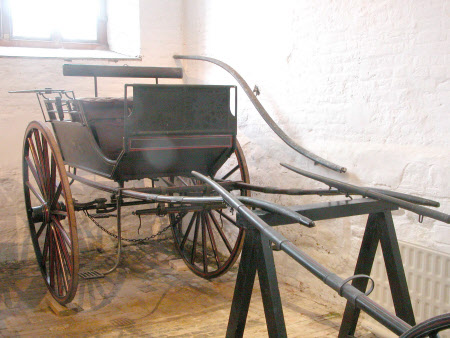Whitechapel cart
Langley
Category
Carriages & other vehicles
Date
1870 - 1900
Materials
Painted wood body with wool cloth upholstery and two iron shod wheels.
Measurements
383.5 x 170 x 193cm (12ft 7in x 5ft 7in x 6ft 4in)
Place of origin
Warwick
Order this imageCollection
Charlecote Park, Warwickshire
NT 534204
Caption
The Lucy family may well have used this carriage out on a days shooting. The spacious area under the seat on a whitechapel cart was ideal for the gundogs or braces of birds. They were also used for trips to market with perhaps a piglet under the seat to be sold. This whitechapel cart was built for the Lucy family by Langley of Warwick between 1870 and 1900 and painted in their favoured colours of black and brown with red and white lining.
Summary
Whitechapel Cart built for the Lucy family by Langley of Warwick between 1870 and 1900. Whitechapel Cart (two wheels) for a single horse or a tandem of horses. This example does not have the typical panelled body but a plank-sided body and a sloping back panel more exaggerated than on many. There is a swingle tree, suspended from the draught bar, connected to the axle by chains. The body of the cart is painted black with a brown frame and brown footboard and toe board. There are fine white lines on the body frame mouldings, and red lines on the toe board. Wheels, shafts, springs and swingle tree painted brown with medium red line and two fine white lines. Crest on side panels.
Full description
Whitechapel Carts were a versatile two wheeled carriages that were very often found on estates. They had plenty of storage space under the seat for either luggage or livestock. They would also have been used to transport gentlemen out on a days shooting with room for the dogs. With a high driver's seat gentlemen owners sometimes used them to driven a tandem of horses. The Whitechapel cart is a dog cart variant which usually has a panelled body. The panel frames extend above the panels so that conventional iron seat rails are not required. This example does not have the typical panelled body but a plank-sided body and a sloping back panel more exaggerated than on many. A swingle tree, suspended from the draught bar, connected to the axle by chains is a further sporting feature. It is surprising then to find that in this example, the shafts, both in length and in height beneath the tug stops, are only suitable for a pony of about 14.0hh. Its quarters would be about 8” below the top of the dashboard and the wheels would be about 103% of its height. It was normal for the dashboard to be approximately the same height as the horse and the wheels to be 80-90% of its height. A 14.0hh pony would look wrong in every way and would be completely dwarfed and over-powered by this cart. Because of this shafts do not appear to be original and must have been changed relatively late in the cart’s life. In the final days of horse-drawn transport, possibly during the second World War, it is likely that just one pony or small cob would have been kept at Charlecote Park and, since this cart was the most versatile and useful, the shafts would have been changed to make it possible to use it.
Provenance
.
Marks and inscriptions
On nearside side panel. : Crest On offside side panel.: Crest On offside axle cap.: LANGLEY WARWICK On nearside axle cap.: LANGLEY WARWICK
Makers and roles
Langley , coach builder
References
Carriage Driving, Feb-Mar 1998, pp.48-49
